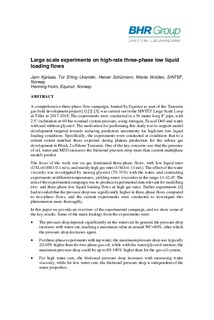Large scale experiments on high-rate three-phase low liquid loading flows
Chapter, Peer reviewed
Published version
Permanent lenke
http://hdl.handle.net/11250/2634717Utgivelsesdato
2019Metadata
Vis full innførselSamlinger
- Publikasjoner fra CRIStin - SINTEF AS [5802]
- SINTEF Industri [1566]
Sammendrag
A comprehensive three-phase flow campaign, funded by Equinor as part of the Tanzania gas field development project [1] [2] [3], was carried out in the SINTEF Large Scale Loop at Tiller in 2017-2018. The experiments were conducted in a 94 meter long 8" pipe, with 2.5° inclination at 60 bar nominal system pressure, using nitrogen, Exxsol D60 and water with and without glycerol. The motivation for performing this study was to support model development targeted towards reducing prediction uncertainty for high-rate low liquid loading conditions. Specifically, the experiments were conducted at conditions that to a certain extent matched those expected during plateau production for the subsea gas development in Block 2 offshore Tanzania. One of the key concerns was that the presence of oil, water and MEG increases the frictional pressure drop more than current multiphase models predict. The focus of the work was on gas dominated three-phase flows, with low liquid rates (USL=0.0001-0.1 m/s), and mainly high gas rates (USG=4-14 m/s). The effect of the water viscosity was investigated by mixing glycerol (70-74%) with the water, and conducting experiments at different temperatures, yielding water viscosities in the range 14-42 cP. The aim of the experimental campaign was to produce experimental data relevant for modelling two- and three-phase low liquid loading flows at high gas rates. Earlier experiments [4] had revealed that the pressure drop was significantly higher in three-phase flows compared to two-phase flows, and the current experiments were conducted to investigate this phenomenon more thoroughly. In this paper we provide an overview of the experimental campaign, and we show some of the key results. Some of the main findings from the experiments were: • The pressure drop depends significantly on the water cut. In general, the pressure drop increases with water cut, reaching a maximum value at around WC=80%, after which the pressure drop decreases again. • For three-phase experiments with tap water, the maximum pressure drop was typically 20-40% higher than for two-phase gas-oil, while with the water/glycerol mixture, the maximum pressure drop could be up to 80-100% higher than for the gas-oil system. • For high water cuts, the frictional pressure drop increases with increasing water viscosity, while for low water cuts, the frictional pressure drop is independent of the water properties.
